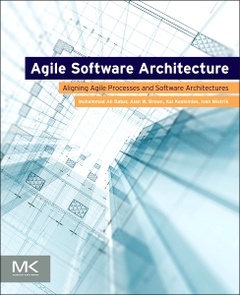Description
Agile Software Architecture
Aligning Agile Processes and Software Architectures
Coordinators: Babar Muhammad Ali, Brown Alan W., Mistrik Ivan
Language: English
Subjects for Agile Software Architecture:
432 p. · 19x23.3 cm · Paperback
Description
/li>Contents
/li>Readership
/li>Biography
/li>Comment
/li>
Agile software development approaches have had significant impact on industrial software development practices. Today, agile software development has penetrated to most IT companies across the globe, with an intention to increase quality, productivity, and profitability. Comprehensive knowledge is needed to understand the architectural challenges involved in adopting and using agile approaches and industrial practices to deal with the development of large, architecturally challenging systems in an agile way.
Agile Software Architecture focuses on gaps in the requirements of applying architecture-centric approaches and principles of agile software development and demystifies the agile architecture paradox. Readers will learn how agile and architectural cultures can co-exist and support each other according to the context. Moreover, this book will also provide useful leads for future research in architecture and agile to bridge such gaps by developing appropriate approaches that incorporate architecturally sound practices in agile methods.
Chapter 1: Introduction to ASA
ASA: The State-of-the-Art
ASA: Industrial/commercial perspective
ASA: Current Challenges and Future Directions
Part I: Fundamentals of Agile Architecting
Chapter 2: The DCI Paradigm: Beyond Class-Oriented Architecture to Object Orientation
Chapter 3: Refactoring software architecture
Chapter 4: Architecture Decisions: Who, How and When?
Part II: Managing Software Architecture in Agile Projects
Chapter 5: Combining agile development and variability handling to achieve adaptable software architectures
Chapter 6: Agile software architecture knowledge management
Chapter 7: Continuous software architecture analysis
Chapter 8: Bridging user stories and software architectures: a guidance support for agile architecting
Part III: Agile Architecting in Specific Domains
Chapter 9: Architecture-centric testing for security: An agile perspective
Chapter 10: Multi-tenancy multi-target architectures: Extending multi-tenancy architectures for agile deployment and development
Part IV: Industrial Viewpoints on Agile Architecting
Chapter 11: Bursting the Agile Bubble Anti-Pattern
Chapter 12: Building a Platform for Innovation: Architecture and Agile as Key Enablers
Chapter 13: Opportunities, threats and limitations of emergent architecture
Chapter 14: Aviva GI: Architecture as a Key Driver for Agile Success
researchers, practitioners, and graduate students of software engineering and software architectures, people working in architecturally sensitive industries (e.g. safety critical systems) and industries migrating to agile
Alan W. Brown is Professor of Entrepreneurship and Innovation in the Surrey Business School, University of Surrey, UK. where he leads activities in the area of corporate entrepreneurship and open innovation models. In addition to teaching activities, he focuses on innovation in a number of practical research areas with regard to global enterprise software delivery, agile
- Presents a consolidated view of the state-of-art and state-of-practice as well as the newest research findings
- Identifies gaps in the requirements of applying architecture-centric approaches and principles of agile software development and demystifies the agile architecture paradox
- Explains whether or not and how agile and architectural cultures can co-exist and support each other depending upon the context
- Provides useful leads for future research in both architecture and agile to bridge such gaps by developing appropriate approaches, which incorporate architecturally sound practices in agile methods

